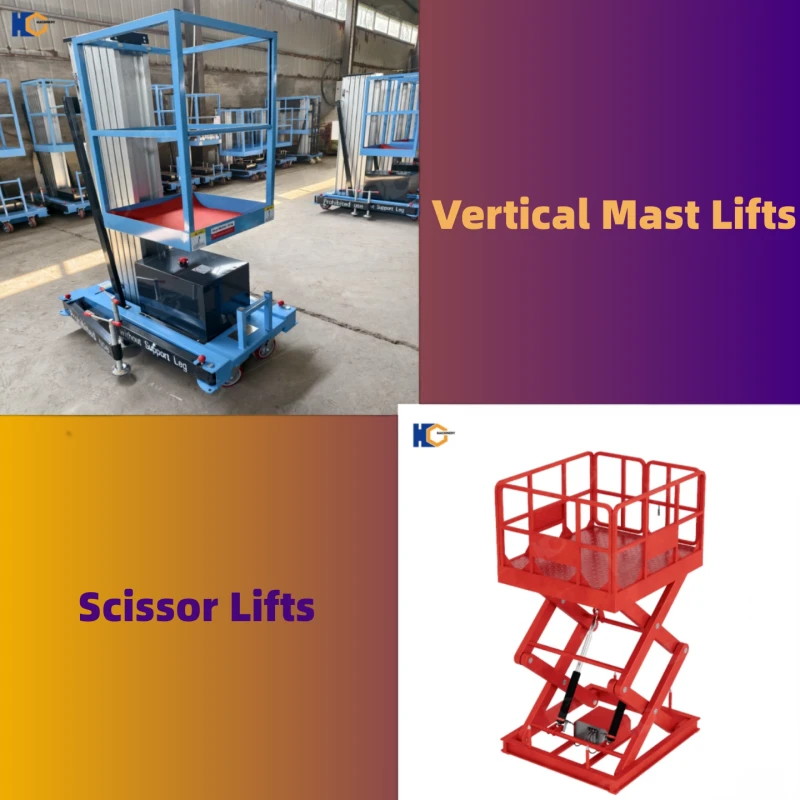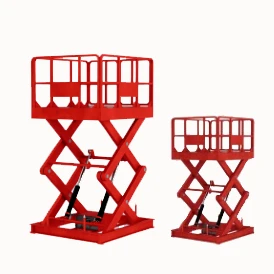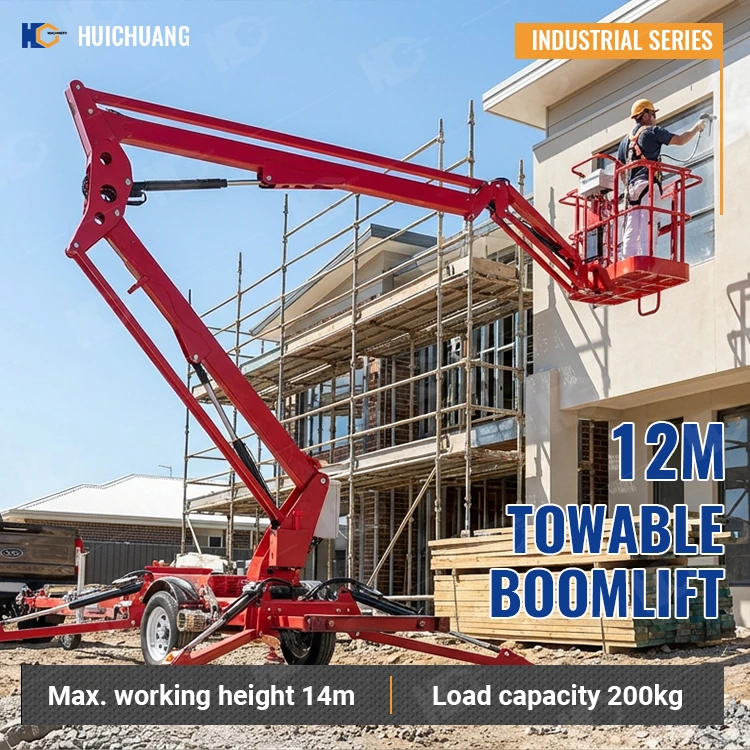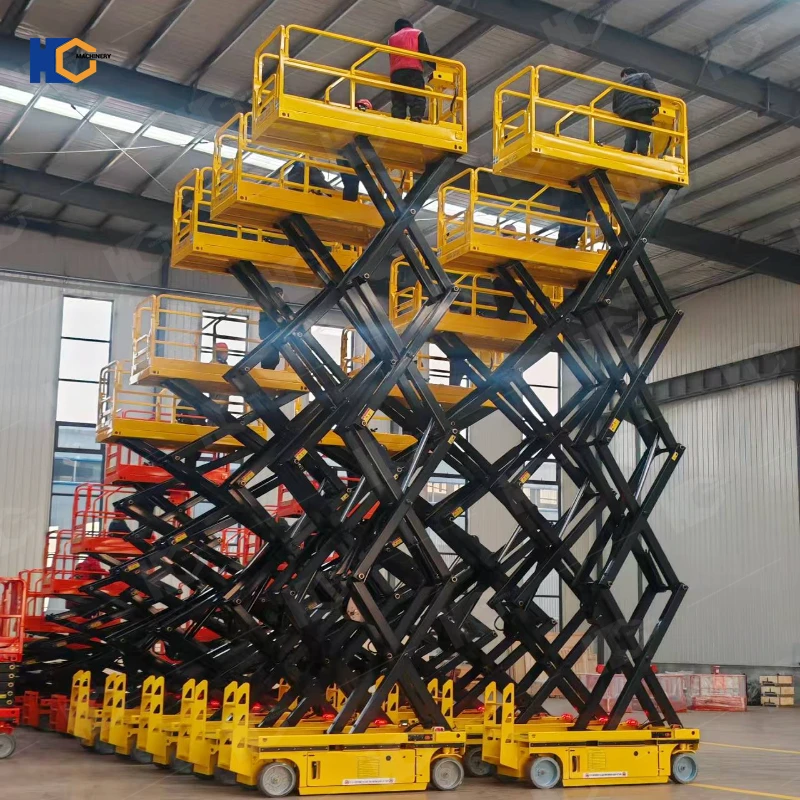Imagine two machines climbing the same vertical axis: one slender as a reed, nimble and unassuming—the vertical mast lift; the other like a robust accordion of steel, broad‑shouldered and steady—the scissor lift. At first glance, both lift people safely—but beneath that similarity lies divergence in design, market dynamics, and user experience. Let’s dissect their contrasts, enrich with data, and show how Huichuang Lift fits into the evolving tapestry.
Anatomy of a Lift: Design & Deployment
Vertical Mast Lifts revolve around a single telescopic mast. Slim and minimalist, they slip through narrow pathways and require minimal turning room.
Scissor Lifts, conversely, rely on a pantograph mechanism—heavy‑duty, broad‑decked, and inherently vertical. That structural difference drives everything from portability to power consumption.
A comparative snapshot:
| Feature | Mast Lift | Scissor Lift |
|---|---|---|
| Typical width vs scissor | ~25% narrower | — |
| Turning Radius | Essentially zero | Requires more clearance |
| Doorway Access | Often ≤ 80 cm width | Rarely feasible |
| Platform Size | Compact, single‑operator | Broad, often multi-person |
This minimalist vs expansive dichotomy defines who's using what and where.
Capacity & Working Envelope: How Much and How Wide?
Scissor lifts clearly win on capacity and space. They offer platforms that can be as much as 40‑60% larger than mast lifts and support heavier payloads—some industrial tables reaching 2,000–4,000 kg—compared to mast lift limits around 120–230 kg for lone operators. Mast designs are transactional machines: compact, swift, single‑user. Scissors are communal: built for crews, cargo, and comfort.
Elevation & Reach: Height Patterns
Mast lifts typically serve the 6–16 m range—fast, vertical climbs in compact contexts.
Scissor lifts often operate in the 6–20 m band and beyond, especially when engine‑powered or built with slide‑out decks. If Huichuang Lift builds hydraulic scissor lifts reaching 16 m, they slot squarely into that high‑capacity niche—where mast lifts simply can’t go.
|
This is one of our scissor lifts, a fixed scissor lift.
Operational Use-Cases: Where Each Lift Shines (and Sometimes Stumbles)
Forget theoretical market charts for a moment—what really matters is how these lifts behave in real-world tasks. Whether you're stocking HVAC units in a commercial warehouse or changing lightbulbs in a hotel atrium, the difference between a vertical mast lift and a scissor lift becomes vividly practical.
Let’s walk through some core use-case zones:
| Application Area | Vertical Mast Lift | Scissor Lift |
|---|---|---|
| Indoor Maintenance | Ideal for narrow corridors, low noise levels | May be too bulky for tight spaces |
| Retail Store Setup | Slips between displays & shelves | Often overkill; turns are limited |
| Outdoor Construction | Not built for uneven ground or heavy-duty use | Robust stability; better for heavy payloads |
| Warehouse Pallet Stacking | Limited platform size | Wide decks perfect for material handling |
| Theater / Convention Lighting | Precise reach without disrupting layout | Requires more space and setup time |
| Airport Terminal Maintenance | Quiet, compact, fast deployment | If space permits; more space to work on ceiling |
Design Intent: Not Just What It Does, But Why It Exists
It’s easy to think of lifts as just tools. But each type is born of a very specific design philosophy:
The vertical mast lift is an answer to tight, delicate, people-dense environments. Think hospitals, data centers, hotels, art galleries. You want a machine that gets in, gets up, and gets out without so much as scratching a pillar.
The scissor lift, meanwhile, was forged in heavier-duty fires. It was built for volume, weight, and width. It’s the trusted friend on job sites, in industrial storage, and on construction slabs where space isn't precious—but payloads are.
In that light, the choice becomes more philosophical than mechanical: Are you navigating space, or conquering it?
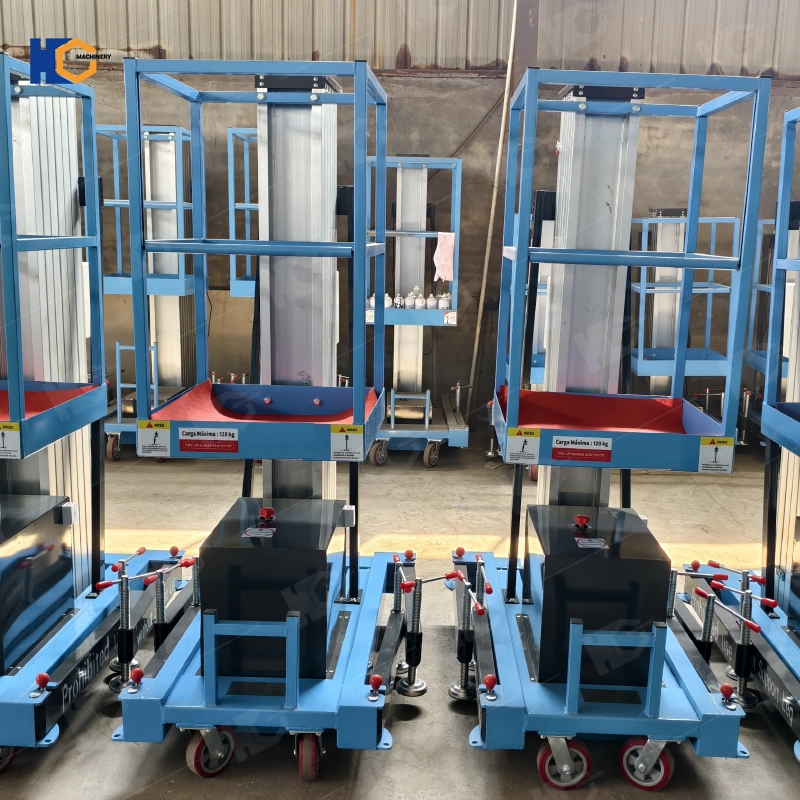
This is one of our vertical mast lifts, also called single-column aluminum alloy lifts.
Real-World Performance: Stability, Setup, and Downtime
Now let’s get technical for a moment. Performance in the field hinges on three often-overlooked traits:
Stability During Full Extension
Scissor lifts—especially electric models—offer inherent lateral stability due to their weight and footprint. Ideal for high ceilings and longer maintenance tasks.
Mast lifts, on the other hand, are stable enough for short-duration work, but wind sway can become a factor above 10 m unless properly balanced or anchored.
Setup and Mobility
Mast lifts win here. Most roll through single doorways and don’t need forklifts to move—especially self-propelled versions.
Scissor lifts require space just to maneuver, and their transport often involves trailers or loading ramps.
Downtime & Maintenance
Scissor lifts involve more hydraulic joints and moving arms, meaning more potential wear points.
Mast lifts, with their simpler architecture, generally require less frequent service and have shorter repair cycles—perfect for facilities that want less disruption.
Customization Options: Tailoring the Lift to the Job
At Huichuang Lift, we’ve long known that no two jobs are alike. That’s why we offer both scissor and mast lifts with modular design features:
Optional platform extensions (for scissor lifts): Slide-out or foldable decks increase reach without sacrificing stability.
Electric vs Hydraulic drive: Choose silent electric motors for indoor use or hydraulic power for outdoor torque.
Safety enhancements: Load sensors, emergency lowering, tilt alarms, and smart diagnostics.
Custom finishes: Anti-rust coatings, non-marking tires, or adjustable rails for sensitive environments like museums or semiconductor clean rooms.
With our own R&D workshops, we’re able to engineer solutions around your real-life obstacles, not just theoretical standards.
Real Jobs, Real Results: When One Type Outperforms the Other
Here are two illustrative scenarios pulled from user experience logs:
Scenario 1: A luxury hotel lobby retrofit
Challenge: Replace chandeliers 8 meters above polished marble without disrupting foot traffic.
Result: A Huichuang self-propelled vertical mast lift completed the job in 3 hours, with no floor damage, thanks to non-marking tires and compact mobility.
Scenario 2: A solar panel installation on a warehouse rooftop
Challenge: Move 300 kg of gear up 10 m safely, on sloped outdoor terrain.
Result: A hydraulic scissor lift with stabilizer outriggers kept workers and gear steady across two full work shifts—no swaying, no slips.
Safety, Standards & Smart Features
Both lift types are now expected to comply with CE, ISO, and ASME A17.1 standards. Huichuang Lift proudly holds these certifications—spotlighting safety sensors, tilt alarms, overload protection, and advanced guardrails. Scissor lifts benefit from their inherent stability; mast lifts demand more precision to avoid sway—but modern models counter that with load sensing and emergency descent features.
Energy & Operating Economy
Electric operation dominates: in 2024, electric scissor lifts held nearly 69% market share, driven by noise reduction, emissions compliance, and lower energy costs.
Energy-wise: electric scissor lifts cost approximately $2.10/hour, whereas diesel units can cost up to $6.80/hour, especially outdoors where rough terrain models are needed.
Mast lifts, being lighter and simpler, cost less to maintain and deploy, especially indoors.
Innovation, Trends, and The Unexpected
Innovation is creeping in from unexpected angles:
Autonomous scissor lifts with AI control
Hydrogen‑powered mast/scissor hybrids
Modular/customizable platform designs
Smart telematics for predictive maintenance and usage optimization
All this makes the traditional mast‑vs‑scissor debate feel like pitting a typewriter against a tablet—similar function, radically evolving form.
Subtle Insights from Practitioners
From field whispers on Reddit, users share cautionary tales: “scissor lifts can be unstable when extended—lots of frictional and angular losses; others comment that they “sway even if you weigh half that much”. While scissor lifts carry more mass—and thus greater inherent stability—those mechanical joints can introduce unwanted motion.
Mast lifts, by contrast, forego multiple joints—but sacrifice platform area and strength. Real‑world users highlight mast lifts’ precision in confined spaces and scissor lifts’ work‑zone robustness.
Huichuang Lift: Where Context Meets Capability
How does Jinan Huichuang Machinery Manufacturing Co., Ltd. integrate into this shifting terrain?
Diverse Product Range: Hydraulic mast lifts for narrow aisles; hydraulic scissor lifts with platform widths and load capacities tailored to warehouse or outdoor tasks; boom lifts for angled access.
Brand Credibility: CE, ISO, ASME certifications guarantee compliance; OEM and bespoke custom solutions satisfy unique customer needs.
Market Footprint: Strong domestic presence in Shandong, and active exports to North & South America, Europe, Southeast Asia.
Innovation & Support: R&D teams working on electric and IoT enabled designs; over 200 staff, multiple workshops, and in‑house showrooms in Jinan.
A Novel Selection Framework: The “ACCESS” Model
Rather than the usual checklist, consider this ACCESS framework:
Aisle-space: If your workspace is ≤1 m wide, mast wins.
Capacity: Need ≥250 kg or multi-operator use? Scissor.
Cost sensitivity: Battery or diesel? Mast is cheaper; scissor electric costs more but spreads with usage.
Elevation needs: Under 16 m? Mast. Up to 20 m or more? Scissor or boom.
Safety comfort: Do you fear sway? Scissors are heavy; mast needs sensors.
Smart integration: If you want fleet analytics, IoT, predictive maintenance—current scissor models lead; mast is catching up.
Use ACCESS to quickly zero in on the right machine—or let Huichuang’s team tailor something bespoke.
Bonus Table: ACCESS Comparison
| ACCESS Factor | Vertical Mast Lift | Scissor Lift |
|---|---|---|
| Aisle‑space | Excellent for ≤1 m corridors | Requires wider space (≥1.2–1.5 m) |
| Capacity | ~120–230 kg (single operator with tools) | 230 kg+; often 400–1000 kg for multi-user |
| Cost | Lower purchase & maintenance | Higher initial cost; lower per-use energy |
| Elevation | Up to ~16 m | Often up to 20 m or more |
| Safety & Stability | Needs anti-sway systems | Heavy base; more inherent stability |
| Smart Tech | Emerging feature set | Advanced telematics and AI integration |
Conclusion: Matching Machine to Mission
The mast lift appeals when agility, simplicity, and indoor mobility matter—you zip around with minimal setup, minimal footprint. The scissor lift answers when workspace, load, and collaboration are top priorities—you haul crews, tools, pallets, and work longer.
Huichuang Lift, rooted in Jinan’s hydraulic platform expertise, sits at the confluence: producing mast lifts that fish between tight aisles, scissors that haul heavier loads and platforms that scale safety far beyond mere regulatory compliance.
Between the slender mast and the sturdy scissor, your choice should be more than a label—it should reflect your site’s width, load, workflow, and future tech adoption. Huichuang is there with the engineered answer. Contact Huichuang today!
